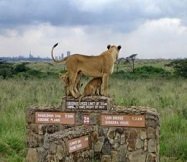Kenya, renowned for its diverse wildlife and stunning landscapes, offers incredible safari experiences year-round. However, certain periods are particularly favorable for wildlife viewing and overall safari enjoyment. This guide will help you determine the best time to embark on your Kenyan safari adventure.
Peak Safari Season (July to October)
- Wildlife Viewing: Excellent, especially in the Maasai Mara
- Great Wildebeest Migration: Witness this spectacular event from July to October
- Weather: Dry and pleasant, ideal for game drives
- Landscape: Golden savannas provide stunning backdrops for photography
- Tip: Book well in advance due to high demand
Shoulder Season (January to February, November to December)
- Wildlife Viewing: Very good, with less crowded parks
- Short Rains: Brief showers in November-December refresh the landscape
- Birdwatching: Excellent for migratory birds (November to April)
- Newborn Animals: Witness young wildlife from December to March
- Tip: Enjoy lower prices and fewer tourists
Green Season (March to May)
- Landscape: Lush and vibrant, perfect for photography
- Wildlife Viewing: Good, but animals are more dispersed
- Birdwatching: Prime time for bird enthusiasts
- Rates: Lowest prices and fewest tourists
- Tip: Be prepared for occasional heavy rains and some road closures
Key Factors to Consider
- Wildlife Interests: Different seasons offer varied wildlife experiences
- Budget: Peak seasons are more expensive than green seasons
- Crowds: July to October is busiest; March to May is quietest
- Weather Preferences: Dry seasons offer easier game viewing; wet seasons showcase lush landscapes
- Specific Parks: Some parks, like Amboseli, are great year-round
Best Time for Popular Safari Destinations
- Maasai Mara: July to October for the wildebeest migration
- Amboseli National Park: June to October for clear views of Mount Kilimanjaro
- Samburu National Reserve: December to March for concentrated wildlife around water sources
- Tsavo East and West: June to October for best wildlife viewing
By considering these factors, you can choose the perfect time for your Kenyan safari, ensuring an unforgettable wildlife experience tailored to your preferences and expectations.
Frequently Asked Questions (FAQs)
Q1: What is the best month for a safari in Kenya?
A: July to October is generally considered the best time, especially for witnessing the Great Wildebeest Migration in the Maasai Mara. However, each season offers unique experiences.
Q2: Can I go on a safari in Kenya during the rainy season?
A: Yes, you can. The “green season” (March to May) offers lush landscapes and great birdwatching opportunities. However, some roads may be difficult to navigate, and wildlife can be more dispersed.
Q3: How far in advance should I book my Kenya safari?
A: For peak season (July to October), book at least 6-12 months in advance. For other times, 3-6 months ahead is usually sufficient.
Q4: Are safaris more expensive during the peak season?
A: Yes, prices are typically higher during the peak season (July to October) due to high demand. The green season (March to May) often offers the best rates.
Q5: What wildlife can I expect to see year-round in Kenya?
A: Many animals, including lions, elephants, giraffes, and various antelope species, can be seen year-round. However, their visibility and concentration may vary with the seasons.
Q6: Is it possible to see the “Big Five” on a Kenyan safari?
A: Yes, Kenya is home to the “Big Five” (lion, leopard, elephant, rhino, and buffalo). Your chances are good in parks like the Maasai Mara, Amboseli, and Tsavo, especially during the dry seasons.
Q7: How does the weather affect safari experiences in Kenya?
A: Dry seasons (June to October, January to February) offer easier wildlife viewing as animals congregate around water sources. Wet seasons provide lush scenery and are great for birdwatching, but some roads may become impassable.


0 Comment